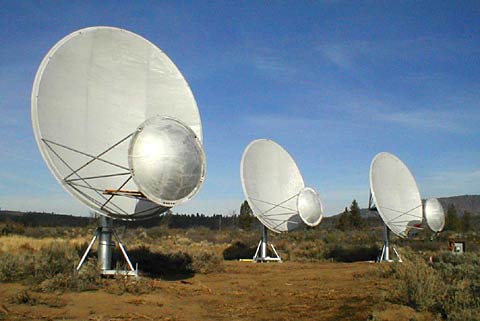
The first three dishes of the Allen Telescope Array in northern California. The ATA's initial SETI project, using 42 dishes, was to be a survey of 20 square degrees of sky covering the galactic center. If massive funding materializes, an array of 350 dishes could eventually be listening to the sky as a tightly linked unit.
Courtesy SETI Institute.
.
Update November 18, 2011: Barely hanging on. Following the Allen Telescope Array's budget crisis and shutdown last April (see below), the SETI Institute launched an internet campaign that raised $229,000 toward resuming operations temporarily. But the longer outlook is grim.
SETI Institute spokesperson Seth Shostak said today that those donations, and the renewal of an Air Force contract to use the ATA to track objects in Earth orbit, have been crucial. "Those two things together are enough to get us back on the air," he said. The shutoff of the electronics last April, he said, created major problems for turning the electronics back on. "People are working hard on that" and may get the ATA running again by mid-December. (Update December 5th: This indeed happened.)
How long it might then stay on us unclear, he said. Maybe a few months, without major new funding.
A rumor is going around the radio-astronomy world that the SETI Institute is looking to sell off the ATA's equipment and close the site. "That's not true," said Shostak. "It's certainly not our intention to shut it down."
In retrospect, the ATA project was overambitions from the start. As a result, it met with unexpectedly difficult and expensive technical challenges during its development, which caused it to fall short of its intended capabilities. Then came the California budget crisis, the great recession, and in 2008, loss of NSF funding due to the ATA's failure to reach its expected level of performance. Meanwhile, serious technical challenges with the receivers still remain. See feature article in Nature (July 27, 2011) telling the history.
---------------------------------------
Update April 25, 2011: The Allen Telescope Array has suspended operations due to lack of funds. According to a CNN article today, "a state budget crisis and reduced federal dollars have choked the project of funding, said Karen Randall, SETI's director of special projects.... The Allen Telescope Array will resume operations by 2013, when [the SETI Institute's] new round of funding goes into effect, Randall said. The funding will cover the project until 2018, she said. In the meantime, SETI is searching for quick cash...."
See also blog post by Franck Marchis.
---------------------------------------
The following article on the Allen Telescope Array, adapted from Sky & Telescope, was last updated March 2010:
The next generation of big radio telescopes won't look anything like the massive dishes of old. Instead of giant steel constructions towering into the sky, the future will belong to more economical arrays of many small antennas hugging the ground. And, in a historic role reversal, searchers for extraterrestrial intelligence have blazed a trail for conventional radio astronomy to follow.
That is the vision behind the Allen Telescope Array (ATA), originally named the One Hectare Telescope — the world's first large radio observatory designed for SETI from the get-go. The SETI Institute and the University of California at Berkeley's Radio Astronomy Lab have built a highly integrated, interferometric array of 42 uniquely designed dishes. With sufficient funding, it could eventually grow to 350 dishes having a total collecting area of about 10,000 square meters (one hectare, or 2.47 acres). The instrument was designed from the outset to be used for ordinary radio astronomy at the same time as it performs its SETI work.
In 2008 the first 42 dishes began science operations at Berkeley's Hat Creek radio observatory site in northern California. Construction beyond ATA-42 will require additional funding that does not yet exist. It took about $50 million to get to ATA-42. The institute has said that the full, 350-dish version will require another $40 million in grants and donations.
The ATA has been funded by private donations through the SETI Institute. The major donor was the family foundation of Microsoft cofounder Paul G. Allen, which gave $30 million. The SETI Institute is also funded by many smaller donors; $50 gets you a one-year membership and a slick magazine, and $100,000 gets your name on a dish.
In 2008 the National Science Foundation (NSF) turned down a proposal to support operations at the array. As of 2009, the $1.5-million-a-year operational costs were being paid by the U.S. Air Force, which uses the array to track satellites and orbital debris, according to a report in the Sept. 17, 2009, issue of Nature. "It's keeping our doors open right now," said ATA director Don Backer. About a third of the ATA's time was going to the Air Force, a third to radio astronomy, and a third to SETI.
Out With the Old
The basic strategy of this new direction in radio astronomy is simple: substitute smart electronics and massive data processing for giant, expensive mechanics.
As computing power grows cheaper, radio engineers can use interferometry to combine signals spanning a very broad range of frequencies from many small, low-cost antenna elements spread out over the ground. This can result in a single, unified instrument capable of performing tricks never before feasible. In particular, the ATA is capable of "multibeaming": using software to observe many separate targets simultaneously in the same patch of sky. The full, 350-dish array will be capable of taking radio images with 15,000 pixels at a time — which may not sound like much compared to a point-and-shoot camera, but is a lot compared to the single big pixel of a traditional radio telescope, or the 7 pixels of the new ALFA multibeam feed at Arecibo.
The ATA's individual dishes are 20 feet (6.1 meters) in diameter, with unobstructed apertures and offset signal feeds. Each dish is equipped with a specially designed receiver that can listen to every frequency in nearly the entire "microwave window" that comes through Earth's atmosphere clearly, from about 0.5 to 11 gigahertz. Given enough computing power, the receivers' outputs could be divided into billions of narrow radio channels, so that each channel can be examined individually for signs of an artificial narrowband signal originating in deep space.
Much of the money and effort have gone into the instrument's "back end," the computers and other parts that integrate and analyze the signals — tasks that have posed severe technical hurdles. In fact, today's computing technology is inadequate to do the full job envisioned. The hope is that computing power will continue to improve, allowing the finished instrument to be upgraded as time goes on.
By 2009, ATA-42 was successfully making various astronomical sky-survey observations, as described by Welch and Tarter in a paper detailing the system's construction and performance.
Targeted vs. Wide-Sky
One SETI strategy announced for the ATA will be to do a targeted search of nearby Sun-like stars, one by one. Eventually the ATA should examine 100,000 or even a million target stars at frequencies across the microwave window — a vast undertaking compared to the 800 or so stars that were targeted at 1.2 to 3.0 gigahertz by the SETI Institute's Project Phoenix (see SETI Searches Today).
But some SETI astronomers have come around to a different view: that the best chance of success is not in targeting nearby stars one by one, but in choosing star-rich swaths of the Milky Way for deep, protracted scrutiny. This strategy looks at a much larger number of stars, even though most of the stars are very far away and thus would require the aliens to be transmitting with truly unearthly power (see Smarter SETI Strategy).
The ATA began work by giving this strategy a try. In May 2009, ATA-42 began searching for artificial signals in a sweep of the Milky Way's
plane toward the galactic center. The area of sky being covered by the Galactic Center Survey is 2° by 10° in size. That's only one two-thousandth of the celestial sphere, but it's an extremely star-rich area, including about 40 billion stars of all types within 30,000 light-years. The survey will cover all the frequencies in the broad “waterhole” range, from 1.42 to 1.72 GHz.
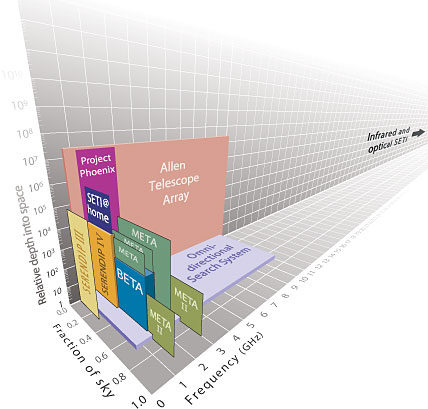
How ATA-350 would compare with other SETI projects. This 3-D graph of SETI 'search space' indicates the sensitivity, frequency coverage, and sky coverage of major radio searches past, present, and future. Clearly, you can't have it all. High sensitivity means limiting yourself to either a small fraction of the sky or a thin range of frequencies. No current or planned search comes near to filling a large volume of the search space.
The values shown for the full Allen Telescope Array (ATA-350) and a future Omnidirectional Search System are tentative. The sensitivity units (vertical) are scaled to indicate the relative volume of space (that is, number of stars) that gets searched for a transmitter of a given power in a given direction.
There are more parameters to consider than just the three graphed here — for example a signal's frequency drift, on-off duty cycle, and polarization. Plotting them all, says Jill Tarter of the SETI Institute, would require a 9-dimensional graph. The 'haystack' to be searched is big indeed.
Sky & Telescope diagram.
Berkeley radio astronomers plan to use some of the ATA's time for such projects as timing pulsars, mapping the hydrogen in the Milky Way and other galaxies, measuring primordial deuterium, and examining the hearts of star-forming regions. Says Leo Blitz, director of the Berkeley Radio Astronomy Lab, "Our goal is nothing short of standing the way radio astronomy has been done up to now on its head."
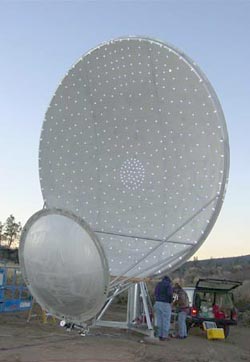
One of the ATA's 6.1-meter antennas. The main dish reflects radio waves to the off-axis subreflector (lower left), which directs them to a pyramid-shaped antenna (concealed within it). The small spots are markers for checking the dish's surface accuracy.
Courtesy SETI Institute.
Still Building
The full array 350 dishes — if it's ever built — will be spread across an area about 0.7 kilometer wide. This design is a compromise. It will yield fairly high resolution for radio astronomy with fairly narrow beams, which, however, are less than optimum for SETI. Wide beams are desirable for SETI searches, because they encompass the most stars at once.
The ATA will eventually listen to many hundreds of millions of channels at once. This band of channels can be marched up and down the microwave spectrum to cover even wider frequency ranges, one block at a time. As the number of simultaneous channels is increased, the ATA's efficiency for SETI work will increase proportionally.
Each of the ATA's simultaneous beams (aimings at separate targets) requires its own data-collection and analysis system. The plan is to start with two or three beams and increase their number to 16 as costs allow.
Thomas Pierson, chief executive officer for the SETI Institute, says an important goal is to provide long-term upgrade capability. "The Allen Telescope Array can be improved constantly, at relatively low cost. For instance, the telescope can be made more powerful by improving the software and incorporating new computing hardware, which continues to get better and less expensive. It can also be made more sensitive by adding more dishes."
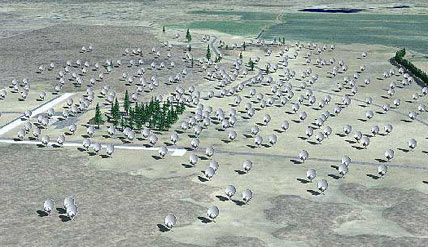
The complete, 350-dish ATA will be scattered in a seemingly random pattern across about 150 acres; denser in the middle, sparser toward the edges. There is more order here than meets the eye, as explained in a SETI Institute article. Click image for full scene.
Courtesy SETI Institute.
Greater Arrays
Bigger projects are also in the works. The ATA is serving as a test bed for some of the ideas revolving around the much more ambitious Square Kilometer Array (SKA), an instrument that radio astronomers worldwide hope to start building in 2013 (as of March 2010) with a target cost of 1.5 billion euros. It would be designed on the same idea of "aperture synthesis" as the ATA but would have 100 times the collecting area of ATA-350 (and would have impressive SETI potential of its own).
A different aperture-synthesis radio telescope is LOFAR, being completed in the Netherlands, which will use 15,000 small antenna elements to make high-resolution images of the sky at low frequencies from 10 to 250 MHz. In April 2010 the Netherlands agency ASTRON announced that LOFAR would embark on a SETI project targeting nearby stars. LOFAR was still under construction but already producing science images. "The first phase of this SETI program will study how contamination from terrestrial transmitters can be weeded out and show the sensitivity of LOFAR for SETI work," according to a press release. "An extended program of looking at the nearby stars is then planned. The first high-spectral resolution spectrum in the test program has just been obtained."
The SETI Institute funded an effort at Ohio State University to push antenna-array efforts a step further. Robert Dixon and Steve Ellington built an early version of an "Omnidirectional Search System" (OSS), a fully "steerable" radio telescope that has no moving parts at all (as with LOFAR). Instead of dishes, each of its elements is a simple, small, fixed antenna sensitive to the entire sky. Aiming was done entirely in software by combining signals from all the antennas through interferometry. Dixon and Ellington dubbed their prototype the Argus omnidirectional radio telescope.
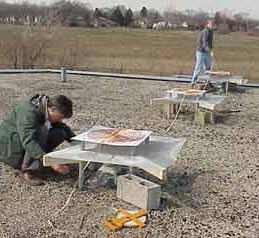
Humble beginnings. This eight-antenna prototype of the Argus omnidirectional radio telescope at Ohio State University represented a new kind of radio telescope: one that relies on massive computing power to synthesize a simultaneous radio image of everything in a vast region of the sky.
Courtesy Ohio State University.
An 8-antenna prototype used 21 computers linked together to process its signals into a dynamic radio map of the sky for a narrow range of frequencies. Its was successfully programmed to blank out artificial interference from satellites crossing the sky; "black spots" in its sensitivity were set to track known problem satellites, hiding them from view.
The limiting factor for this ambitious idea is lack of sufficient computing power. To see the whole sky, each antenna must be very small, hardly larger than the wavelength itself; no dishes allowed. So the total collecting area is tiny. And if even a small, 64-antenna array were to scan and fully analyze all available microwave frequencies, it would require the power of about 100,000 desktop computers.
And as for a full-up version, one capable of watching all the sky well at all good microwave frequencies all the time?
"The present estimate," said the SETI Institute's Frank Drake, "is that a computer system which can carry out about ten to the twentieth power calculations per second is required. This is presently beyond both our technical and financial capability. However, if the increases in computer power and decreases in cost follow their historical trends — that is, following Moore's Law [which suggests that computing power per dollar doubles every 18 months] — the required capability at an affordable cost should be available in perhaps a decade."
------------------------
Alan M. MacRobert is a senior editor of Sky & Telescope.
 0
0









Comments
You must be logged in to post a comment.